UCAVs are unmanned combat areal vehicles used in a combat environment for various rules including interdiction, intelligence, reconnaissance, and a variety of other usages. In recent years, the prevalence of UCAV systems greatly increased as a result of advancing technical standards and the constantly evolving combat ecosystem.
1. Why Does it Matter?:
UCAVs are quickly becoming the indispensable feature of any developed or developing nation’s areal capabilities. With the advent of artificial intelligence, sophisticated weapons systems and newer materials, the UCAV will rapidly dominate the skies in the next 10 to 15 years. Perhaps even sooner, nation-states will forgo costly and complex manned air operations in favour of remotely piloted aircraft capable of performing the same functions that a manned aircraft is able to achieve.
2. So What’s the Difference:
There is a healthy deal of confusion over what exactly is a UCAV and what separates one from an unmanned aerial vehicle (UAV) or unmanned aerial system (UAS). To begin with, a UAV is any aircraft without a pilot, either replaced by remote ground-based piloting or semi-autonomous controls. Very often, one may see the acronym RPA or ‘remote pilot aircraft’. The actual difference between a UAV and RPA is mostly pedantic and can be used interchangeably [source].
A UAS refers to all the avionics, sensors, cameras and other electronic systems onboard a UAV. In other words, a UAV is merely the airframe. A UAS is the UAV airframe combined with all of the electronic components which make the UAV work. In short, every UAS is a UAV, but not every UAV is a UAS [source].
A UCAV is a UAV which operates in a combat environment. Its main purpose is to conduct combat air operations. This may include air-to-ground or even air-to-air operations. Most UCAVs you see today are MALE systems or medium altitude long endurance aircraft. UCAVs conduct battlefield intelligence, surveillance and reconnaissance (ISR) as well as targeted strikes [source]. UCAVs are strikingly useful for several reasons:
- The lack of a pilot means that UAV/UCAVs can perform high-G manoeuvres without risking pilot blackout or injury.
- The lack of a pilot also means a relatively cheap operating price and training cost.
- It is relatively easy to train operators on UAVs and UCAVs.
- The lack of a pilot also minimizes potential loss of life should the aircraft be downed.
- UAV/UCAVs can perform a wide variety of missions and be configured for multiple purposes, whereas conversion among manned aircraft is traditionally more difficult and time-consuming.
- UAVs and UCAVs can be made small and generally undetectable.
- The cost-effectiveness of UAV/UCAVs greatly enhances a nation’s COIN capabilities.
3. A Brief History of the UCAV
In 1849, the Hapsburg Empire lay siege to the port city of Venice with a device heretofore unseen by any military observer. The First Italian War of Independence, in the wider context of the Risorgimento, was sparked by the wave of popular uprisings we collectively know today as the Springtime of Nations. Six months prior, the Hapsburg war machine crushed the Kingdom of Piedmont-Sardinia and recaptured the tiny Republic of San Marco. Venice however, with its strategically vital waterway, stood resolute against Austrian dominion. In order to counter the Italian challenge, Vienna would bring to bear an admittedly whimsical, even farcical solution [source].
The aquatic geography of Venice resulted in two main frustrations for the Austrian forces. First, the boggy marshland prevented Austrian heavy and long-range artillery from moving close enough to bombard the city. Second, Venetian coastal defences seriously threatened the superior, albeit exposed Austro-Hungarian Navy. The famed Austrian general, Josef von Radetzky, tasked his artillery officers with developing a solution. The answer came in the form of a young lieutenant from Theresienfeld, Franz von Uchatius [source].

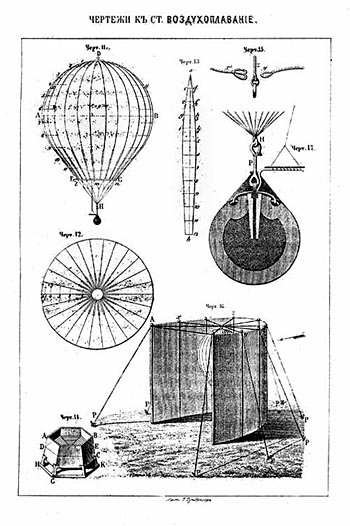
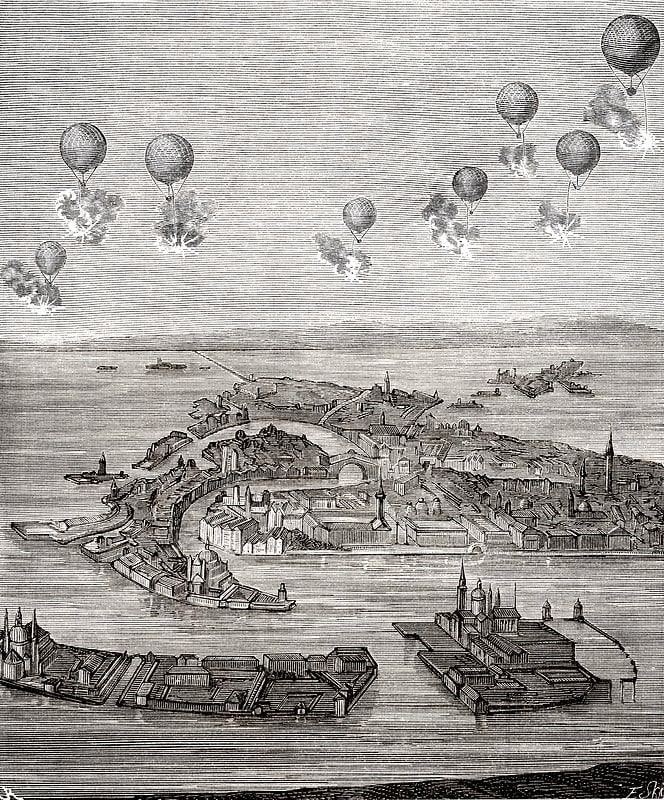
Uchatius devised a fleet of hot air balloons, each carrying a payload of explosives. Using a timed fuse made from charcoal and cotton string greased with animal fat, Uchatius made an imprecise calculation as to when the balloons would be over the city, given the prevailing winds and launch locations. The greased strings would then be ignited by an electrical charge using a copper wire. In July of 1849, several balloons were launched from land as well as the SMS Vulcano. It was the first instance of naval aviation in history [source], [source].
The design simply did not work as intended. No targets were hit, and several balloons were carried by the changing winds back over the Austrian lines where they promptly exploded. On August 22d, the Austrians gave it another go, this time managing to strike at least a number of their targets. The damage done was so negligible that General Radetzky did not attempt a third sortie [source].
Given the embarrassment of the balloon operation, one may think that the story of unmanned areal combat ended over the untouched spires of Venice. Yet despite the abject failure, precisely the opposite took place. Unmanned air combat, in a sense, took off.
3.1. The Modern Era of Unmanned Flight:
The concept of an autonomous flying combat platform predates the outbreak of the Cold War by about a decade. In 1940, Popular Mechanics ran an article about a little-known inventor, Dr Lee De Forest and his partner, U. A. Sanabria. Forest was a groundbreaking, revolutionary thinker, often named one the “fathers of the electronic age” for his innovations in electrical engineering. Dr Forest’s usual beat was long-distance broadcasting, radio and television, so his 1940 feature in Popular Mechanics perhaps came as a slight surprise to an industry which associated him with commercial broadcasting devices [source].
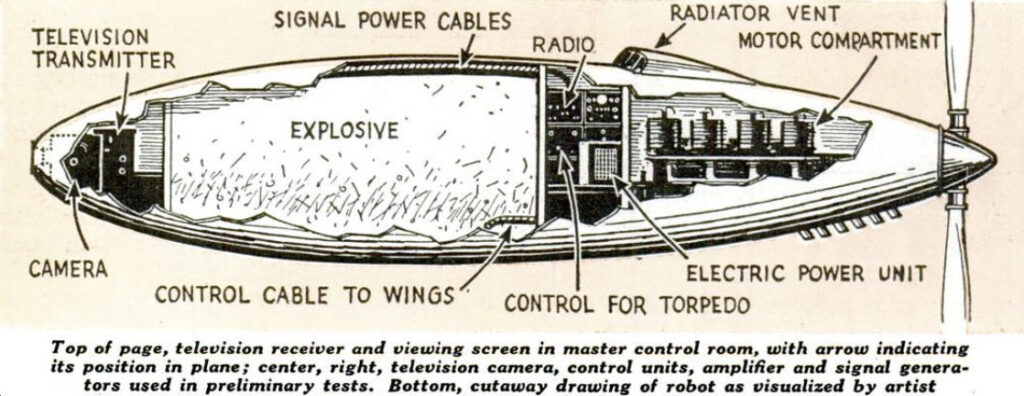
The article bore the clunky headline: “Robot Television Bomber”. A bizarre, V-winged, canopy-less depiction of this robot television bomber was accompanied by a B-17 Flying Fortress over what is presumably an enemy factory. The article begins:
Dr Forest’s robot bomb is not by any measure a UACV as we would understand the concept today. The future of UCAV designs would be far more sophisticated. This design is far more so a suicide drone, rather than a fully autonomous and reusable air vehicle. It required roughly the same level of technical sophistication to develop something like the V-2 rocket or the early WWI pilotless aeroplanes [source].

What separated Dr Forest’s proposal from other, earlier attempts at unmanned aircraft was the radio-television controls which enabled a ground-based crew to pilot the vehicle with television cameras [source]. The very first true UAV, the Hewitt-Sperry Automatic Airplane, was in effect a rudimentary cruise missile, but it had no means of transmitting images of the battlefield back to the ground crew [source].
3.2. Early Attempts at Pilotless Aircraft:
In 1944, Dr Foster’s concept was put to the test during Operations Aphrodite and Anvil. B-17 and PB4Y bombers were stripped out of non-essential instruments, packed with explosives and outfitted with radio piloting equipment. A controller aircraft would then guide the bombers into German submarine pens. The operations had limited success and are generally considered a failure. Moreover, like the WWI pilotless aircraft, Aphrodite bombers are better understood as cruise missiles or precision-guided munitions [source].
3.3. From Robots to Lawnmowers:
Throughout the First World War, the Interwar period and the Second World War, no modern observer would fairly credit any of the designs available to major industrial powers as UAVs. The world of unmanned flight took a major leap forward in 1965 when the former head of the Lawrence Radiation Lab (now known as the Lawrence Livermore National Laboratory) was appointed to the position of Director of Defense Research and Engineering at the Pentagon. John Stuart Foster Jr. long maintained his childhood hobby of building and flying model aeroplanes. As the Pentagon’s chief weapons designer, he merely scaled up his childhood pastime [source].

He affixed two lawnmower engines to a series of prototypes, strapped with bombs and cameras, not unlike Dr Forests’ earlier designs. And so, in 1973, the military put to flight the very first UAVs as recognized by a 21st-century audience. “Praeire” and “Calere”, as the prototypes were known, were able to remain airborne for less than two hours and carry a payload of 28 lbs of test bombs. These two test vehicles would propel UCAV systems into the future. Foster had proven the mechanical and technical feasibility of the concept, but it would be up to the nation-state to prove the effectiveness of the platform in combat [source].
3.4. Proving its Worth:
Foster’s very first UAV flight in 1973 almost perfectly coincided with another major milestone of drone warfare. In October of that year, a coalition of four Arab nations launched a surprise assault on Israel. The Egyptian Air Force totally caught the Israeli Air Force off guard on the first day of the war, with disastrous consequences. Having been appointed to the position of Israeli Air Chief five months prior to the war, Gen. Benny Peled was aware that Washington had warned Tel Aviv of an imminent attack [source]. Peled was also aware that the Americans expressly forbade Israel to launch preemptive strikes [source].
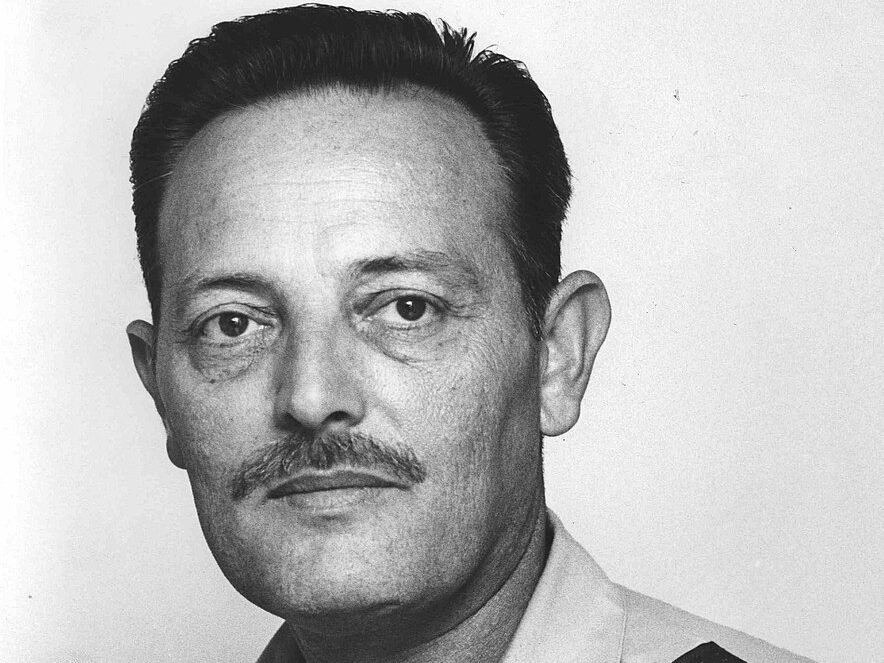
On the first day of the way, Peled told Gen. David Elazar, the Israeli chief of staff, that the decision to hold off on preemptive strikes would prove fatal. He conveyed to Elazar that should he not be given permission to launch preemptive operations by 3 PM, he would order the entire F-4 Phantom fleet to be converted from bombers into interceptors. Peled gave the order to do so by 1 PM. By 2 PM, the first of the Arab attacks had already begun, and Israel’s Phantoms sat bare in hangars, totally useless to the war effort [source].
Peled ordered the available aircraft into the air, but Israeli air power was complicated by the presence of Soviet-made anti-aircraft missiles on the Egyptian front. Realizing the futility of throwing expensive jets against a brick wall of solid anti-aircraft defences, Defense Minister Moshe Dayan ordered Peled to send the Phantoms north to the Syrian border, where they were desperately needed [source], [source].
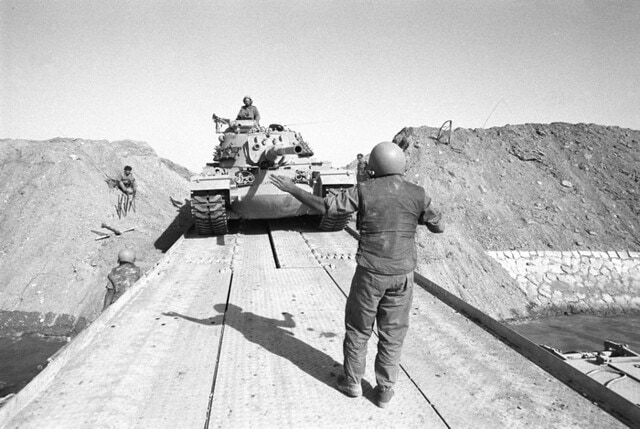
Much of the credit for breaking through Egyptian missile defences must go to Israeli tank crews who blasted their way through Sinai. Yet, a good deal of credit is also due to the hands of unmanned target drones which were deliberately flown over Egyptian airspace. Peled came up with an innovative solution.
Using American-made Firebee target drones, Peled ordered the drones to be equipped with chaff and electronic countermeasure suites. The BQM-34B Firebee was the very first jet-powered drone in existence. It was mostly used as a target decoy for training purposes but was used in reconnaissance missions in Southeast Asia as well [source]. Armed with Peled’s new adjustments, the Firebee became a veritable nuisance for Egyptian missile crews.
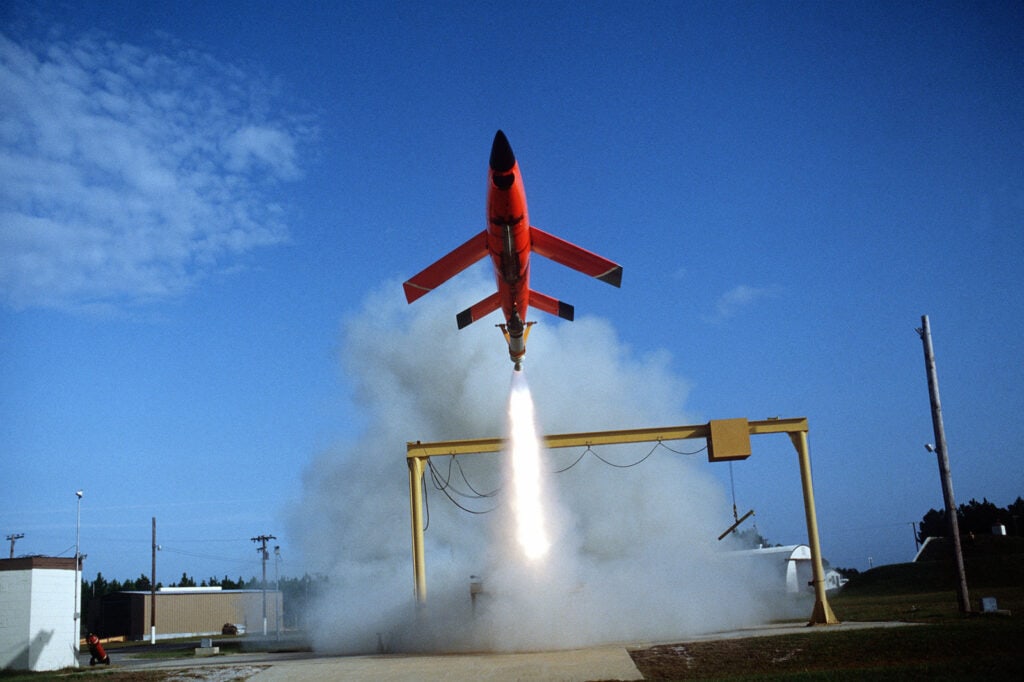
Many of the Firebees were armed with SHRIKE anti-radiation missiles. Flying in formation, the drones would confuse Egyptian SAM sites into believing that the Israelis were mounting an all-out air assault [source]. By drawing missile fire away from the actual fighter bombers, the drones virtually expended the entire Egyptian SAM arsenal in a matter of days. This allowed Israeli to neutralize the SAM sites, establish air dominance and gave an opportunity for the drones to strike radar stations with the SHRIKE missiles. It is reported that one single Firebee drone wasted at least 31 Egyptian missiles, none of which actually hit the drone. The Israelis repeated this tactic during the 1982 Lebanon War with Syrian missile batteries [source]. Peled’s brilliant strategy touched on four very crucial elements which secured Israeli victory:
- The use of Firebee drones in mass formation gave the impression among Arab military planners that Israel was prepared to and capable of matching the invasion force.
- The Israeli Air Force made excellent use of the Firebee as a platform for missile strikes as well as decoys.
- The tactic had the added advantage of being cost-effective relative to the expenditure of the entire Egyptian missile arsenal.
- The Firebee drone itself was non-essential and easily replaceable to the war effort, whereas the F-4 Phantoms were not.
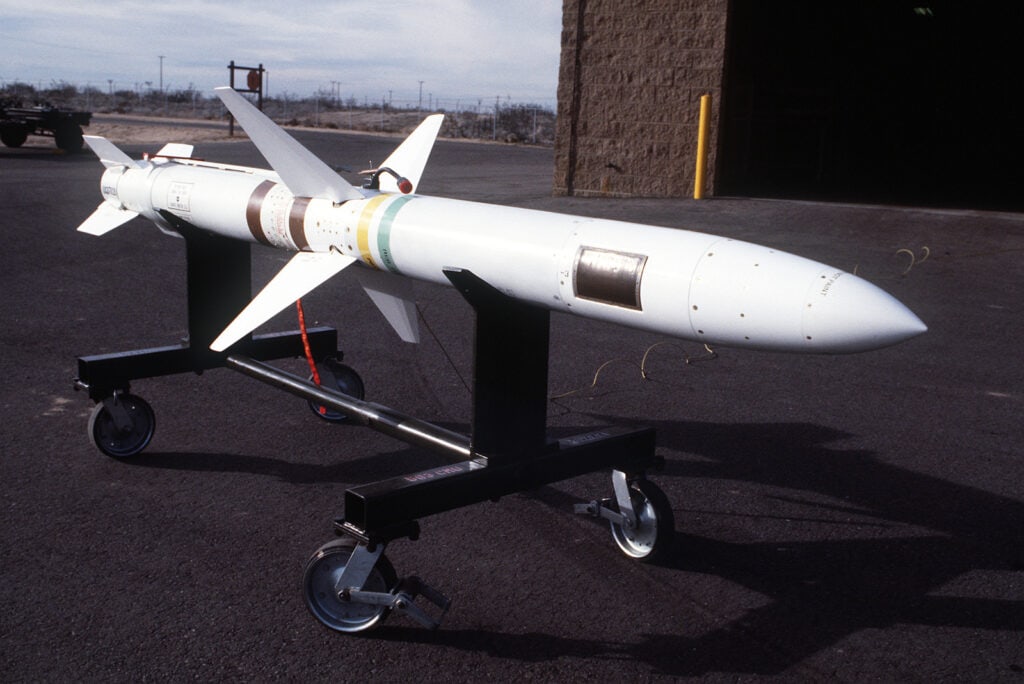
3.5. No Pilot, No Problem:
More crucially, the Firebees proved to be an effective platform for the SHRIKE air-to-surface missiles. The US Air Force took notice of the wildly successful drone operation in Sinai. HAVE LEMON, a US project to develop the Firebee into an air combat platform slightly predated the Egyptian episode. Although the project was shelved in 1979, HAVE LEMON demonstrated to US military planners the value of unmanned drones in combat [source]. A test match between 2 F-4 Phantoms and 2 modified Firebee drones resulted in a definitive win for the Firebees. At the start of the exercise, the F-4 pilots engaged the target drones head-on. The drones pulled a 6 G turn almost immediately and continued to perform high-G manoeuvres until the Phantoms, initially the hunters, became the prey. The F-4s did not manage to land a single hit on either of the drones [source]. The Firebees were able to pull evasive manoeuvres well beyond the tolerance of a human pilot. Yet one problem remained with unmanned air vehicles throughout the 1970s and 80s, a lack of real-time controls. Data transmission and communications with drones were still in their infancy [source].
4. The Gulf Wars and the War on Terror:
In a near-simultaneous fashion, drone warfare entered into its modern phase with the introduction of satellites, the internet and mass communication. High-bandwidth data communication systems allowed for real-time battlefield awareness and responsiveness [source]. The level of delay between ground commands and drone response was almost virtually eliminated. First fielded in the Balkans during the Yugoslav Wars, the MQ-1 Predator proved to be a vastly superior alternative to manned reconnaissance missions. More to the point, it also proved to be highly effective at striking targets with air-to-ground ordnance.
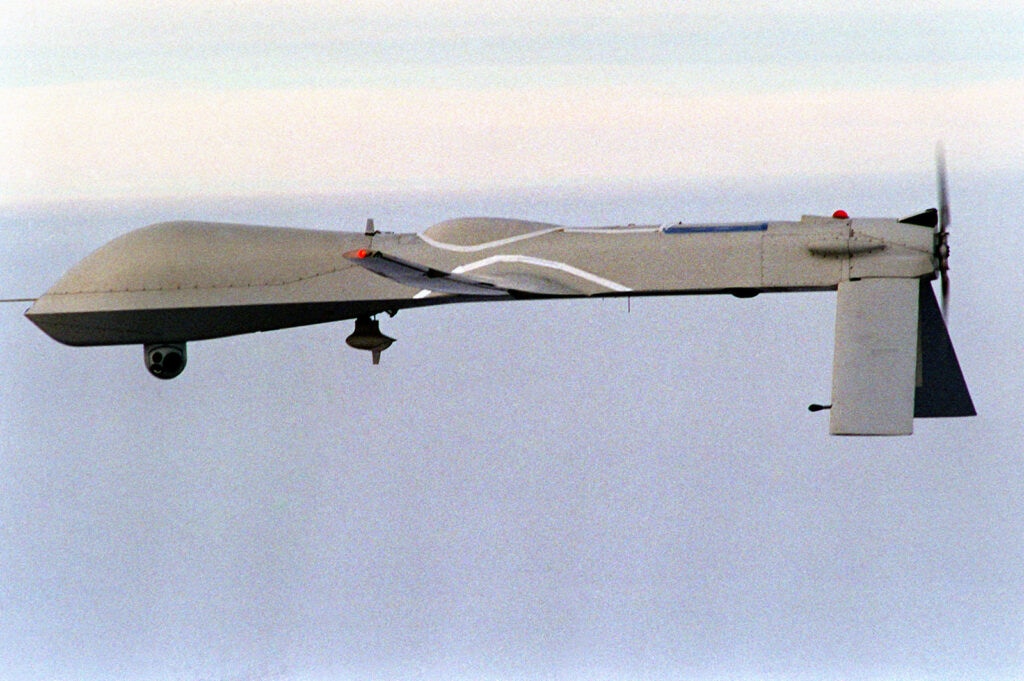
During the First Gulf War, there was always at least one UAV operational above Iraqi airspace at any given moment. The use of UAV systems greatly enhanced US operational capabilities and left little room for improvement. In the aftermath of the September 11th attacks, the Global War on Terror would come to be largely conducted by these autonomous areal systems [source]. The two most notable examples of UAV designs fielded by the US military during the War on Terror is the MQ-9 Reaper and the MQ-1 Predator.

From striking high-value targets to collecting intelligence and conducting forward observation, the MQ-1 and MQ-9 have performed a variety of roles in between. It is important to note that drone warfare in the form we recognize today is a relatively recent invention. The MQ-1 was only introduced to the battlefield environment in 1994. Most UAVs in the US Military’s current inventory were developed post-2001. From Iraq to Afghanistan the use of drone systems became ever more so refined and sculpted. There is hardly any country today which does not already have UAVs in its arsenal or is currently attempting to acquire or produce its own. Nevertheless, the United States is the country which still boasts some of the most advanced UAV systems thus far produced. The following is a non-exhaustive list of US made drone systems currently or formerly in service with the United States Military:
- General Atomics MQ-1 Predator
- General Atomics MQ-1C Gray Eagle
- AAI RQ-2 Pioneer
- AeroVironment RQ-14 Dragon Eye
- Northrop Grumman RQ-4 Global Hawk
- Northrop Grumman MQ-4C Triton
- Northrop Grumman MQ-8C Fire Scout
- AAI RQ-7 Shadow
- Boeing Insitu RQ-21 Blackjack
- AeroVironment RQ-11 Raven
- Lockheed Martin RQ-170 Sentinel
- Northrop Grumman RQ-18O
- Boeing MQ-25 Stingray
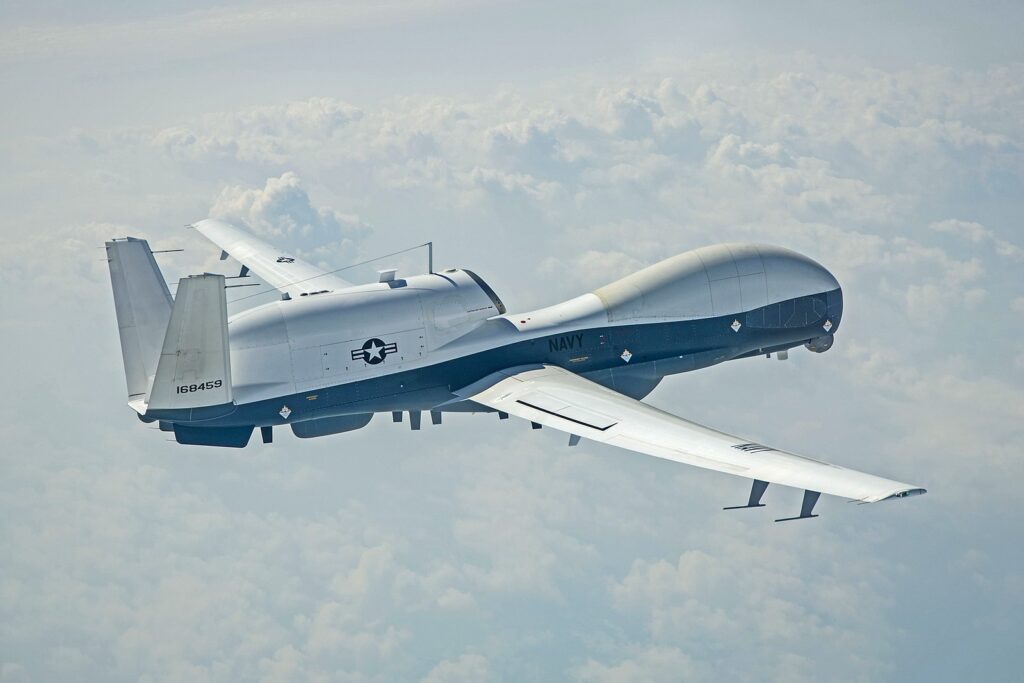
5. Turkey, Ukraine and Russia:
It was only until very recently that the concept of a UCAV, separate from a UAV, crystalized and became well-defined. This is thanks in large part to the efforts of Turkey. The US pioneered the use of UCAV systems with the MQ-1 and MQ-9 designs, more so than any other country, but the US will typically deploy only one UCAV per mission. That is to say, there is a little recorded instance of US Military assets utilizing a multitude of drones for a single purpose. At most, two or three UAVs may be used to accomplish the same task, be it target acquisition, FAC or ISR. In 2020, Turkey demonstrated a dramatic alteration to that calculus.
5.1 The Bayraktar TB2 in Action:
The Baykar Bayraktar TB2 UCAV has gained a place of almost sacred reverence by Ukrainians due to its widespread use by the Ukrainian Armed Forces. Bayraktar videos perform well on social media sites and the TB2 is even honoured by a folk song sung in Russian. Bayraktars have been used so extensively by the Ukrainians that Baykar, the Bayraktar’s manufacturer, has plans to set up a manufacturing plant in Ukraine [source].

Turkish drones have been employed to great effect across central Asia and north Africa. The forces of Libyan warlord Khalifa Haftar found themselves on the receiving end of Turkish drones in 2019 when the Government of the National Accord acquired several Turkish units. Armenian troops experienced a similar fate throughout the various short conflicts of the previous few years with Azerbaijan [source], [source].
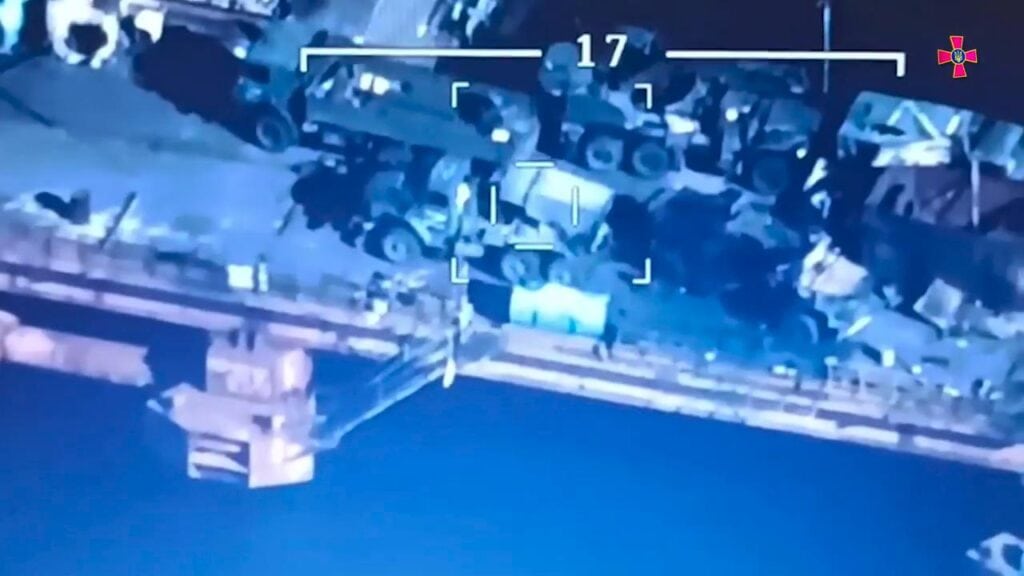
5.2 Turkish Drone Doctrine in Syria:
When Turkey invaded northern Syria, it encountered a quagmire of quilted mortal enemies who totally opposed Turkish intervention. The only thing that the Syrian Kurds, the Assad regime and Islamic extremists appear to have ever mutually agreed upon was their distaste for Turkish interference. In the face of such hostility and collective opposition, it is evident that Turkish military planners took note of American successes with UAVs and applied the concept on a larger, more coordinated scale [source].
At the outset of the Turkish invasion, a massive wave of Bayraktar drones crossed into Syrian airspace and wreaked total havoc. An unknown but sufficiently large number of Baykar Bayraktar TB2 UCAVs were flown in a “coordinated” fashion and used to support infantry operations, strike targets, conduct battlefield surveillance and seek out artillery positions. The Syrian Arab Army was explicitly targeted, with tanks, vehicles and anti-aircraft systems left churned by the Bayraktar’s. It is the first time in history that UAV/UCAVs were deployed in a coordinated and systemic fashion in a conventional battlefield setting [source].
6. The Kızılelma UCAV:
Building off the success of the TB2, Baykar began the production of the widely expected UCAV system in March of this year. The Kızılelma is unlike any other UCAV concept. It will perform the duties of a traditional UCAV such as intelligence gathering and reconnaissance, as well as striking targets. However, beyond that, the Kızılelma will radically alter the air combat environment. The Kızılelma is the world’s very first unmanned fighter aircraft [source].

There a several revolutionary and groundbreaking features of the Kızılelma:
- A ‘low observable’, or stealth, a configuration capable of evading radar-based defenses [source].
- The ability to operate off the deck of an aircraft carrier. While the Kızılelma is not the first naval drone (see the Northrop Grumman MQ-4C Triton), it is the second such airframe compatible with an aircraft carrier after the X-47B [source].
- A single, TF-6000 engine capable of accelerating the Kızılelma at speeds exceeding Mach 2, placing the Kızılelma in an extremely rare category of supersonic drones [source].
The Kızılelma can be fastened with around 1,500 kg of weapons payload and avionics with a large variety of compatible ordnance. It is expected to have a maximum range of 930 km [source]. The aircraft also bears two canards on the forward fuselage to improve handling.
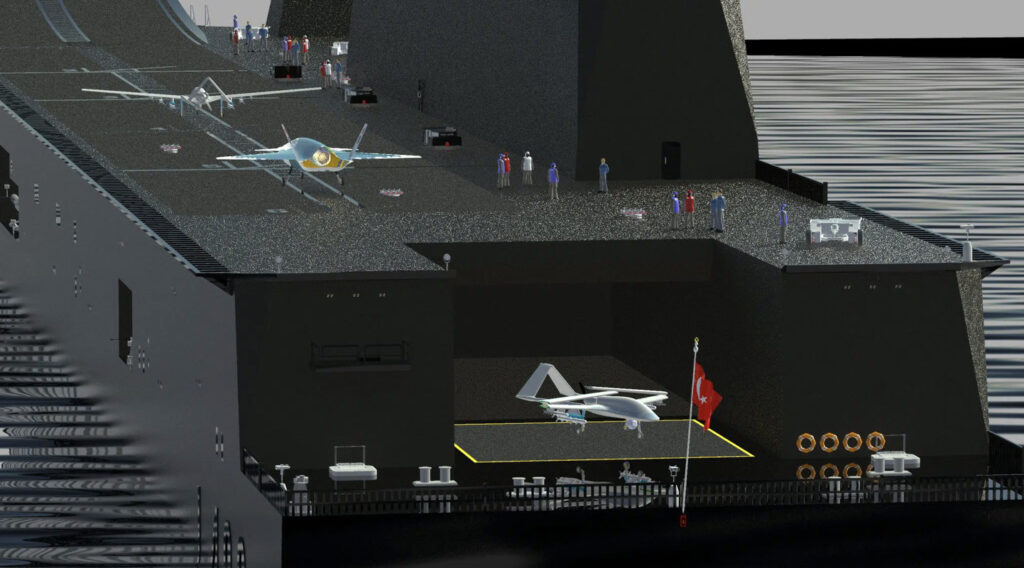
These canards are typically seen on supersonic aircraft such as the Dassault Rafale, Saab 37 Viggen or the Eurofighter Typhoon. The canards are a form of compromise in terms of aircraft design. They are needed for pitch control as the Kızılelma does not appear to have a horizontal stabilizer found on traditional jet fighters. They also enhance in-flight stability, which is especially important at supersonic speeds. However, the canards increase the radar cross-section of the aircraft per the sharp, abutting angular surfaces [source]. The decision to include canards in the final design is an issue of trade-offs between two key elements of Kızılelma’s design, low observability and speed.
7. Future of UCAVs:
With the introduction of the Kızılelma, other countries are sure to follow suit and develop comparable aircraft systems. The concept offers several major bonuses. There is no need to train and maintain the skills of a human pilot or put that pilot’s life in danger. There is also the option of launching carrier-based swarms of UCAVs, potentially altering the nature of naval aviation permanently. On top of this, a UCAV can perform high-G manoeuvres which would otherwise render a pilot unconscious or even dead. That alone could dramatically change how air combat is conducted.
Perhaps the best argument in favour of the UCAV is limiting the risk to the pilot and the cost to the government. Taken together with the technological advances of the last decade, the integration of UCAV systems into national militaries is a win-win situation. It is readily clear that the UCAV will dominate the skies of future conflicts.

